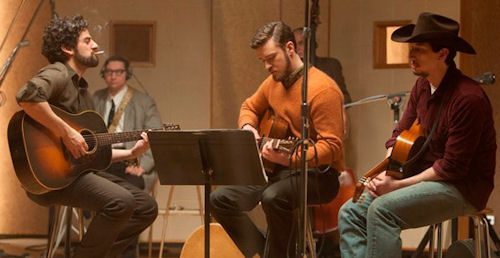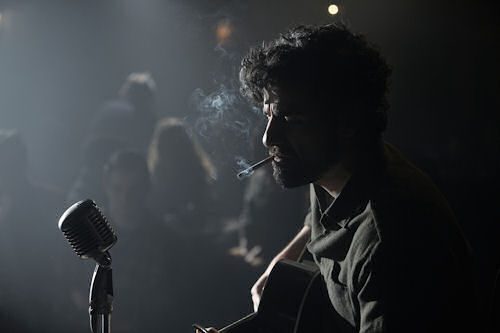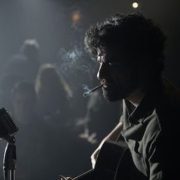INSIDE LLEWYN DAVIS
THE COEN BROTHERS’ ROCKY ROAD TO GREENWICH VILLAGE
 There were two versions of the Folk Revival available to viewers this evening: on PBS a rerun of John Sebastian’s hosting a program called Folk Rewind, with performances by the Kingston Trio, The Highwayman, The Limelighters, Harry Belafonte, Judy Collins and others who made folk music a commercial success in the early 1960s, and on the big screen, the long-awaited premiere of the Coen Brothers “remembrance of things past,” a film homage to the Greenwich Village folk scene of 1961, when Bob Dylan hit town in the dead of winter and joined a budding revival that was to move folk music out of the fraternity circuit and into a major cultural force that fueled the civil rights and antiwar movements. Based on a character modeled on Dave Van Ronk, herein called Llewyn Davis, a young, bearded folk singer in love with traditional music who runs into a burgeoning singer-songwriter crowd with whom he is decidedly and humorously out of sync. So much so that when he hears a young army recruit who is on leave for the weekend to play at The Gaslight Club in the village he dismisses his new song The Last Thing On My Mind with a raised eyebrow, realizing that his brand of folk music is about to be replaced with pseudo folk songs by performers like “Troy” who is clearly modeled on Tom Paxton. To see what became of “Troy” see my latest concert review of Tom Paxton at McCabe’s. Another member of the same club is named “Al Cody” who is modeled on real-life folk singer-songwriter Mark Spoelstra, about whom I wrote in my review of Tom Rush earlier this year. Except that the real Mark Spoelstra came out of Club 47 in Cambridge, along with Joan Baez, more so than the Gaslight in the Village.
There were two versions of the Folk Revival available to viewers this evening: on PBS a rerun of John Sebastian’s hosting a program called Folk Rewind, with performances by the Kingston Trio, The Highwayman, The Limelighters, Harry Belafonte, Judy Collins and others who made folk music a commercial success in the early 1960s, and on the big screen, the long-awaited premiere of the Coen Brothers “remembrance of things past,” a film homage to the Greenwich Village folk scene of 1961, when Bob Dylan hit town in the dead of winter and joined a budding revival that was to move folk music out of the fraternity circuit and into a major cultural force that fueled the civil rights and antiwar movements. Based on a character modeled on Dave Van Ronk, herein called Llewyn Davis, a young, bearded folk singer in love with traditional music who runs into a burgeoning singer-songwriter crowd with whom he is decidedly and humorously out of sync. So much so that when he hears a young army recruit who is on leave for the weekend to play at The Gaslight Club in the village he dismisses his new song The Last Thing On My Mind with a raised eyebrow, realizing that his brand of folk music is about to be replaced with pseudo folk songs by performers like “Troy” who is clearly modeled on Tom Paxton. To see what became of “Troy” see my latest concert review of Tom Paxton at McCabe’s. Another member of the same club is named “Al Cody” who is modeled on real-life folk singer-songwriter Mark Spoelstra, about whom I wrote in my review of Tom Rush earlier this year. Except that the real Mark Spoelstra came out of Club 47 in Cambridge, along with Joan Baez, more so than the Gaslight in the Village.
Sometimes the Coen Brothers don’t bother to change the names to protect the guilty, using the real-life “Jim and Jean” whole cloth as the couple whose couch Llewyn Davis winds up calling home, though in between other couches in other rooms.
Jim and Jean created one great album entitled Changes, after the title song by Phil Ochs, whom he had taught to play guitar back in Ohio. I actually talked to Jim about a year ago, after receiving an email from him in response to one of my reviews of the recent movie about Phil Ochs produced by his brother Michael. What is Jim up to now? Spinning more elaborate Kennedy conspiracy theories than I had ever encountered, and convinced that he had gotten to the bottom of the mother of all conspiracies in American history. As moved as I was to be in touch with an artist who had once meant something to me I just did not want to go down that particular rabbit hole at this time, content with putting my own small tribute together for JFK, which we just held last November 22, on the 50th anniversary of the assassination.
The movie thus takes place during a more innocent time; before the death of the president, when a new breed of songwriter entered the American scene, determined to carry out the vision pioneered by Woody Guthrie a generation before. Dave Van Ronk was their midwife; it was his couch Bob Dylan slept on, and he who taught Dylan his arrangement of The House of the Rising Sun that wound up on Dylan’s first record—much to Van Ronk’s consternation. In the Coen Brothers beautiful follow-up to O Brother, Where Art Thou?—an earlier homage to traditional music—we see the early sixties folk revival through the struggling soon-to-be-disenchanted eyes of Van Ronk—nee Davis—who even has a record with the same title as the real record Inside Dave Van Ronk, released on Prestige/Folklore in that same year. It is refreshing in many ways to see this renaissance in contemporary folk music through the eyes of a true traditionalist—one whose finger-picking guitar style would capture the attention of dozens of imitators and disciples, including Dylan. Credit the film’s music producer T-Bone Burnett with absolutely stunning renditions of a superlative soundtrack of God-honest American and British folk songs, many of them performed by the lead actor himself, the brilliantly talented and haunting Oscar Isaac.
The soundtrack recording—which I managed to secure as a free giveaway to the first fifty movie-goers (I got the second-to-the-last one) at the first Thursday sneak preview screening at 10:05pm at the ArcLight in Hollywood at Sunset and Vine—is flawlessly credited to the traditional and contemporary sources for each song, including my friend Len Chandler’s (and poet Robert Kauffman’s) Green Green Rocky Road, which they elaborated and refined from a children’s ring game collected in Alabama by folklorist Harold Courlander—who as the collector I am happy to add to the credits for the song.
The closing credits to the movie are played over the real Dave Van Ronk’s recording of Len’s song, after it had already been played earlier in the movie by “Llewyn Davis,” on a lovely vintage acoustic Gibson guitar. I am thrilled—as I know Len will be—to know that his significant contribution to the folk canon was featured not once but twice in the film. T-Bone Burnett found a gem and knew what to do with it; the song demonstrates to perfection the power of Llewan Davis’s finger-picking guitar style, played in drop-D tuning. To hear a song like that next to the Highwayman’s clomp clomp guitar-strumming behind Michael Row the Boat Ashore in the PBS special is like night and day—the difference between real art and a commercial substitute. The Coen Brothers and T-Bone Burnett’s aesthetic taste is unerring—they go instinctively to some of the most beautiful songs in modern folk music—including Ewan MacColl’s The Shoals of Herring, which Davis sings to his senile father in a terribly moving farewell scene, before he is to ship out in the Merchant Marines to try and make enough money to get through the winter. It is one of the more powerful scenes in the movie, showing above all the depth of this music and its ability to hold two people in its grasp. The love of father to son revealed in Oscar Isaac’s extraordinarily expressive eyes is truly a wonder to behold. Put that one scene in the Oscar voters’ envelopes and look no further. He’s got my vote—if I had one. But I don’t; so this must count as my strongest recommendation to see this movie.
How many ways can you say “masterpiece”? Two thumbs up; four stars; a perfect 10; any one will do. The movie is both a masterpiece of storytelling and music. Even if their were no music in it the fictional story based on true events would rivet your attention: A down-on-his-luck folk singer hits town and no sooner lands on this couple’s couch than he gets the wife pregnant. Or does he? In the days before fast-and-simple DNA tests she doesn’t know if it’s his or her husband’s. So to be sure she doesn’t complicate everyone’s life beyond imagining she decides on an abortion. Turns out it’s not the first abortion in Llewyn’s life; or is it? That too becomes more complicated than it first appears.
 How is he going to pay for it, when he can’t even pay for a meal, or a roof over his head?
How is he going to pay for it, when he can’t even pay for a meal, or a roof over his head?
Fate intervenes and offers him a recording session with—guess who?—Justin Timberlake. It’s a faux protest song about not wanting to be an astronaut and asking President Kennedy to release him from the space program. Well, as soon as you recognize Justin Timberlake (the last person you want to see in a movie about traditional music) you realize this has monster hit written all over it. Llewyn Davis’s problems and financial angst are solved? Well, he manages to talk himself out of a stake in the song’s future royalties by insisting on getting paid up front—just $200 for the session, thank you and goodbye. The abortion won’t wait for “future royalties.” Like Stephen Foster selling his songs to the Christy Minstrels for $10 here and $5 there, you quickly see how musicians were exploited by the recording industry.
And speaking of royalties, it is not only certain well-known musicians who are satirized in the movie, the Coen Brothers go after the doyen of recorded folk music: Moses Asch himself, founder of Folkways Records. Portrayed in the film as “Mel,” there is a great scene where Davis as Van Ronk tries to get a royalty check out of “Mel,” only to be put off with one lame excuse after another, until Mel finally concedes that for two years of steady record sales he may owe him…$40. In the real-life version of this comic gem of a scene, Moe Asch pours over his accounting books and says to Van Ronk, “Oh Dave, why it says here I owe you $25.” It was apparently the only money he ever got out of Moe Asch, who was notoriously tight-fisted about paying his artists for the records that became the crown jewels of American folk music—from Leadbelly to Woody Guthrie to Pete Seeger. No wonder Dylan wanted nothing to do with them.
Guess what? The times, they aren’t a-changing: no sooner has this movie hit the marketplace than Smithsonian Folkways has capitalized on its commercial potential to release a brand new boxed set of Dave Van Ronk from their inestimable treasury of his recordings. I hope his widow and family get more this time around than he ever did in his lifetime. (You can go on their web site and order it.)
While this epic journey through America’s cultural underground is seen through the artist who became known as “The Mayor of MacDougal Street”—the title of Van Ronk’s memoir and in part the source for this movie—much of the visual iconography of the film is inescapably Dylan’s. You see Llewyn Davis walking down a wintry New York cityscape in a scene that could have been lifted right off the cover of The Freewheelin’ Bob Dylan—except for the missing Susie Rotolo on his arm. If you wonder about their association with the real Van Ronk, we have a photo of the three together.
But even more intriguing and illustrious of Dylan’s enduring hold on our collective imagination is the role of the central nonhuman figure in the film: a photogenic cat that could have been lifted right of the cover of Dylan’s fifth album—Bringing It All Back Home, the one where he is photographed with his manager Al Grossman’s beautiful wife in the background. Dylan is holding the cat securely in his arms, and that image in a real sense propels this movie forward.
Because the first thing Llewyn Davis does is lose another friend’s cat, whose couch he is also sleeping on, and who escapes from a briefly opened door. Davis’s search for folk music glory is part-and-parcel of his on-going search for the missing cat, a remarkable feat of storytelling that takes many forays—from a serendipitous walk in the Village’s winding narrow downtown streets where he thinks he has found the cat to a long road trip to Chicago during which he thinks he has run it over, only to discover eventually that the cat found its own way back home—just like Dylan’s album cover promises.
And then the brilliance of the Coen Brothers’ feline motif reveals itself—just as it had become the thread that wound all the way through O Brother, Where Art Thou? so here does one gradually realize that this is not just any epic—this is the Ur-epic, Homer’s Odyssey retold in the context of New York City’s nascent folk revival of 1961.
The cat’s name is Ulysses—the Latin version of the Greek Odysseus. And sure enough, he finds his way back to Ithaca—nee Greenwich Village. It is a living monument to Homer’s enduring poetic landscape—one that served James Joyce in his epic novel (sixteen years in the making) Ulysses—and one that here grounds the Coen Brothers in their second Homeric epic: Inside Llewyn Davis.
The time frame of the movie is equally integrated into this great thematic framing device: it opens at the Gaslight in 1961, with Llewyn Davis on stage singing a song that John Lomax (again, I am happy to add the complete credit for the song) collected from an African-American washerwoman named “Dink.” This Lomax called it simply Dink’s Song.” It is also known as Fare Thee Well, O Honey. Burl Ives did it beautifully, though without Oscar Isaac’s beautiful fingerstyle guitar accompaniment. And so did Dylan, whose early bootleg recording a friend once sent me on a tape cassette. Well, just like The House of the Rising Sun it appears that Dylan learned it from Van Ronk, whose magical recording of Len Chandler and Bob Kaufman’s Green Green Rocky Road underlies the film’s closing credits.
But the opening scene is deceiving, because it winds up being the set up for the closing scene as well, when one finally realizes that Davis (the Coen Brothers) has been telling the story backwards—until it ends on the same note that T.S. Eliot articulated so eloquently in The Four Quartets: In my end is my beginning. For it is just at that point that Davis is about to leave the Gaslight and folk music and ship out (O shades of Woody Guthrie and Cisco Houston!) in the Merchant Marines that he overhears (and we see in a shaded half-light) the next act that follows him.
I don’t want to give the ending away; let’s just say that he is skinny and wearing a harmonica holder, and Davis’s ineluctably sad eyes reveal he has seen the future, and he can now be only a dim part of it. This final musical treasure from the film is also called Fare Thee Well, but it is a completely different song—one that derives from the Clancy Brothers’ (also portrayed in the movie) version of The Leaving of Liverpool (which I am also happy to credit to its original and traditional source.)
Here is where the movie truly circles back on itself: this obscure version of Dylan’s (you didn’t hear it from me) folk classic was unearthed from the Fort Knox of CBS Columbia Records vaults and is here unbelievably released for the first time. It is a thrilling studio version that the Coen Brothers and T-Bone Burnett knew would send chills up the spine of any folk music fan for whom this movie will be essential viewing. Don’t miss it!
And for the final nod to Bob, when one opens up the beautiful old-world packaging of the soundtrack CD it almost looks like an old black-and-white Folkways Record—complete with lyrics to all the traditional songs, and lovely photos from the film. And right dead center is a rough-hewn drawing of an acoustic guitar, with the sound hole looking right at you with what to these sore eyes appear to be Bob Dylan’s famous “eye” logo. Or is it CBS’s? After all, the first words you see on the screen are “CBS Films.”
Here’s looking at you, kid; though, as you once said, Don’t Look Back. But I’m glad and grateful the Coen Brothers did. Go see Inside Llewyn Davis. It brings it all back home.
Ross Altman hosts In Memoriam John Lennon this Sunday, December 8 from 7:30 to 9:30pm at The Talking Stick, 1411 Lincoln Blvd in Venice, CA 90291. Performers include Paul Zollo, Jeff Gold, Robert Wayne and Jill Fenimore. 310-450-6052. Free.
Ross Altman may be reached at greygoosemusic@aol.com













